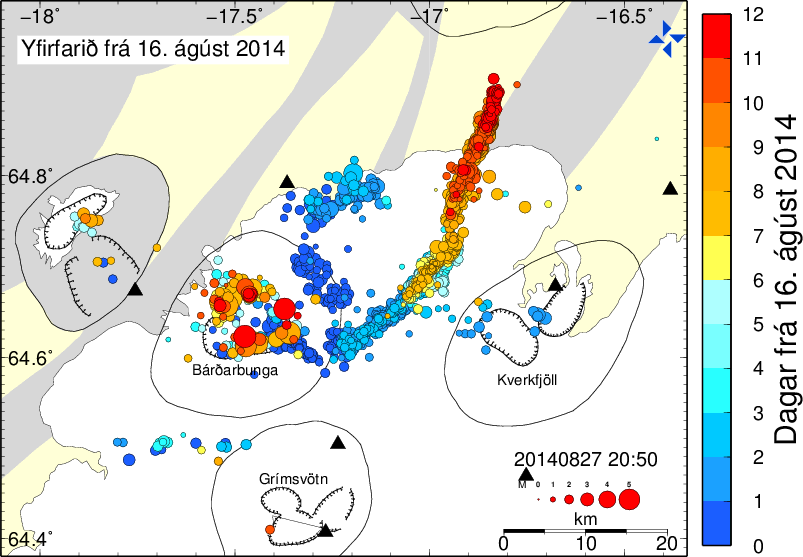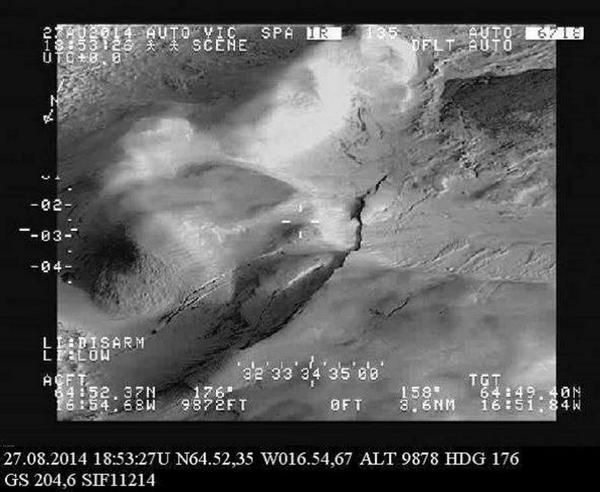Quakes Keep Shaking Iceland's Bardarbunga Volcano

Earthquakes are still rocking Iceland as lava pushes through a long underground fissure near the ice-covered Bardarbunga volcano.
By 6:42 p.m. local time (2:42 p.m. EDT) today (Aug. 27), the Icelandic Meteorological Office (IMO) had detected about 1,300 tremors in the region, most of the them originating from the subsurface channel being carved out by magma, or molten rock. The long channel is called a dike.
Late in the day, the discovery of a long depression above the southeast edge of Bardarbunga's caldera sparked new speculation about an eruption. A team of scientists flew over the area this afternoon and spotted the new feature in the ice. A 2.5- to 4-mile-long (4 to 6 kilometers) row of cracks and sinkholes described as "cauldrons" appeared above where the dike emerges underground and drills to the northeast. The sinkholes are 32 to 50 feet deep (10 to 15 meters), the IMO said. As much as 10.5 billion gallons of water (40 million liters) could have melted and gone missing under the ice, the University of Iceland said. [See photos of Iceland's booming Bardarbunga volcano]
Officials have not yet determined if an eruption under the ice caused the surface of the glacier to sink. Right now, the distored surface is the only indication of an eruption. Officials would also like to see two other signs, which have yet to appear: the characteristic seismic signals created when hot lava melts ice; and meltwater escaping from the glacier. Another inspection flight is planned for tomorrow morning, the IMO said.

An earthquake swarm started on Aug. 16 around Iceland's Bardarbunga volcano, which is buried under the northwestern edge of the huge Vatnajökull ice cap. So far, no eruption has occurred, but scientists are closely monitoring seismic activity and the movement of the lava-filled fissure, called an intrusive dike, which could potentially spark an eruption or unleash a flood of melted glacial water if it breaks through the surface.
The dike, now thought to be about 25 miles (40 kilometers) long, was first detected underneath Iceland's Dyngjujökull glacier. In the past day alone, this channel has gained 706 million cubic feet (20 million cubic meters) of magma, and it now extends some 7.5 miles (12 km) north of the glacier's edge, according to the IMO.
Overnight, a 4.5-magnitude earthquake shook the eastern side of the nearby Askja volcano. IMO scientists said this could be a sign that the dike is causing stress changes over a large area around the Bardarbunga volcano.
Sign up for the Live Science daily newsletter now
Get the world’s most fascinating discoveries delivered straight to your inbox.
If the dike keeps creeping northwards, it could reach the Askja volcanic system, according to scientists at Cambridge University. The ash fall from a massive eruption at Askja in 1875 made subsistence farming in northeast Iceland impossible, but Cambridge scientists said there is still no guarantee that an eruption will take place this time, and the dike stretching from Bardarbunga may not even reach as far as Askja.
Even so, the event in progress could already be considered "a significant magmatic and tectonic event," Páll Einarsson, a geophysicist at the University of Iceland, said in a statement.
"In terms of [the] seismicity, volumes and displacements involved, only two events in recent decades are comparable to this one," Einarsson said. "These are the Gjálp eruption in the Bardarbunga area in 1996 and the Krafla rifting episode of 1975-1989."
The Cambridge scientists said the volume of magma moving under and beyond Bardarbunga is already twice the size of the magma volume from the Eyjafjallajökull eruption of 2010, which forced thousands of flights to be canceled after it spewed ash over a large swath of Europe.
Live Science senior writer Becky Oskin contributed to this story.
Follow Megan Gannon on Twitter and Google+. Follow us @livescience, Facebook & Google+. Original article on Live Science.











